Abstract
The first comparative study on predicting post-test distress (conceptualised by intrusion and avoidance, measured with the Impact of Event Scale) after presymptomatic genetic testing for Huntington's disease (HD, n=25), cancer syndromes (familial adenomatous polyposis (FAP, n=23)), and hereditary breast and ovarian cancer (HBOC, n=10) is reported. The variables with the highest predictive potential of post-test distress are presented. Participants who were depressed before the test were more distressed after testing, but we found that those who were anxious before the test were less distressed, that is, had less intrusive thoughts post-test. Other factors associated with a higher level of post-test intrusion were gender (being a woman), having children, and pre-test intrusion. Religion and being at risk for HBOC were associated with less post-test intrusion. Participants who showed avoidance behaviour before the test and those who had many people available for support showed more avoidance behaviour post-test. The test result did not additionally contribute to post-test distress. The prima facie simple notion that the test result, as such, determines the distress experienced seems to be a misrepresentation of the complex reality.
Full text
PDF
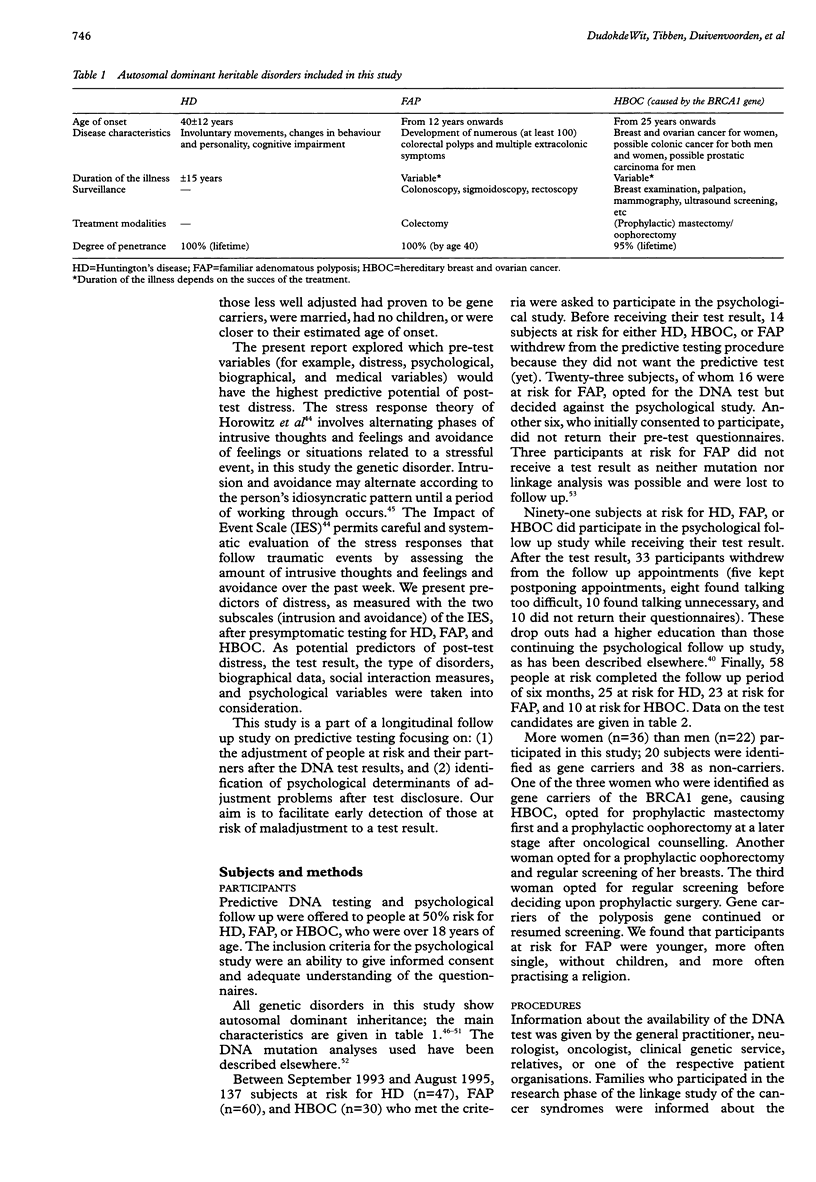
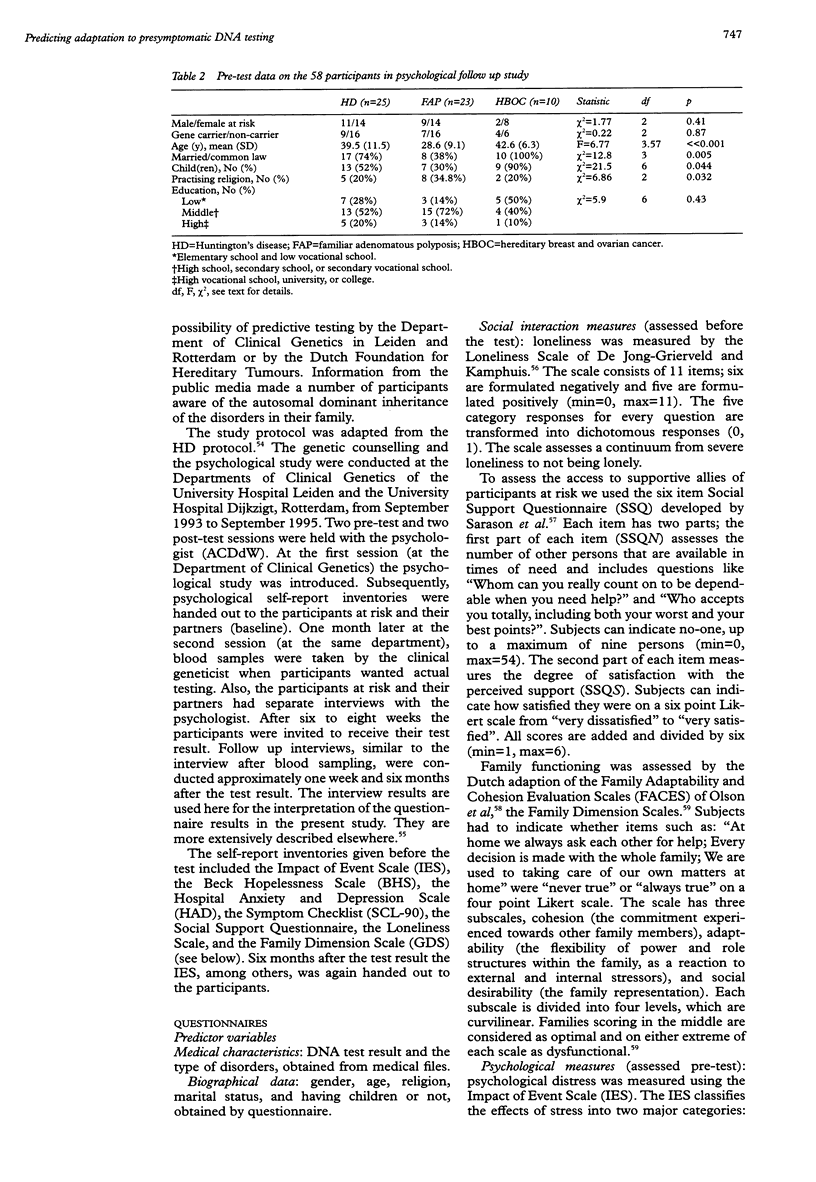
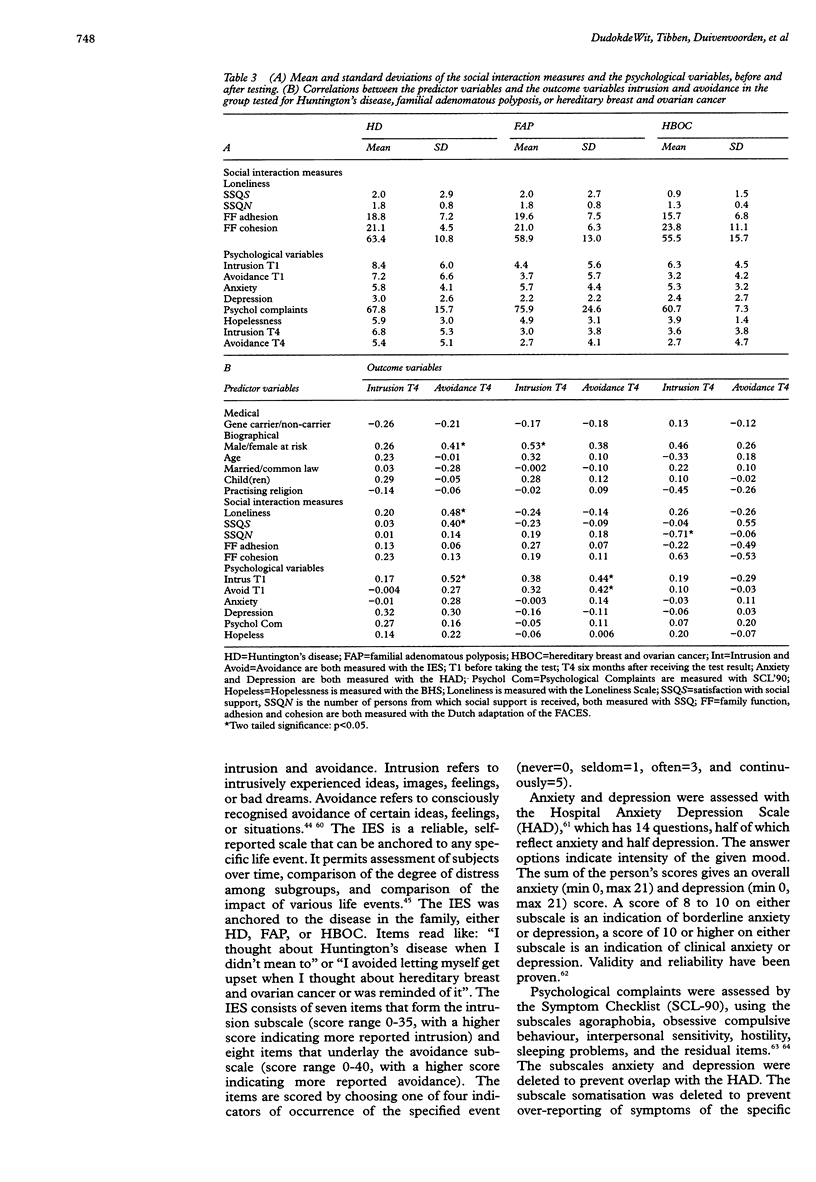

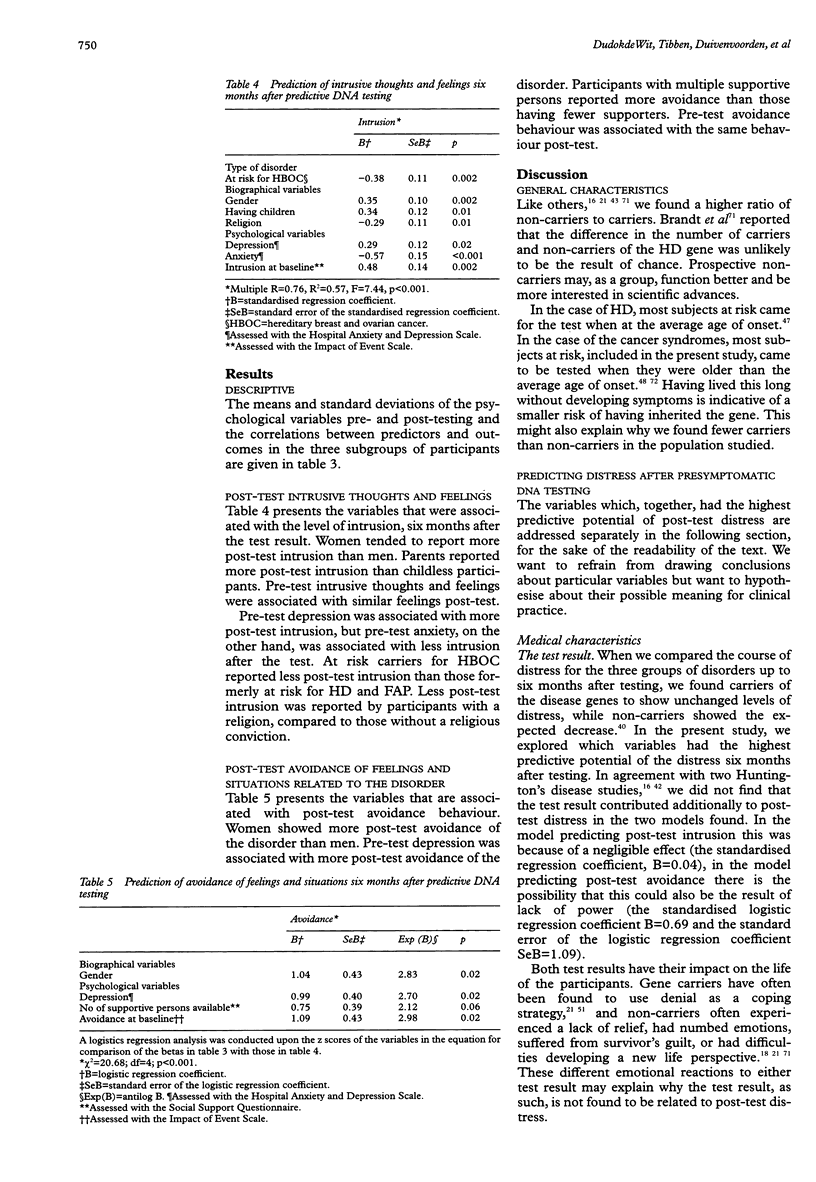
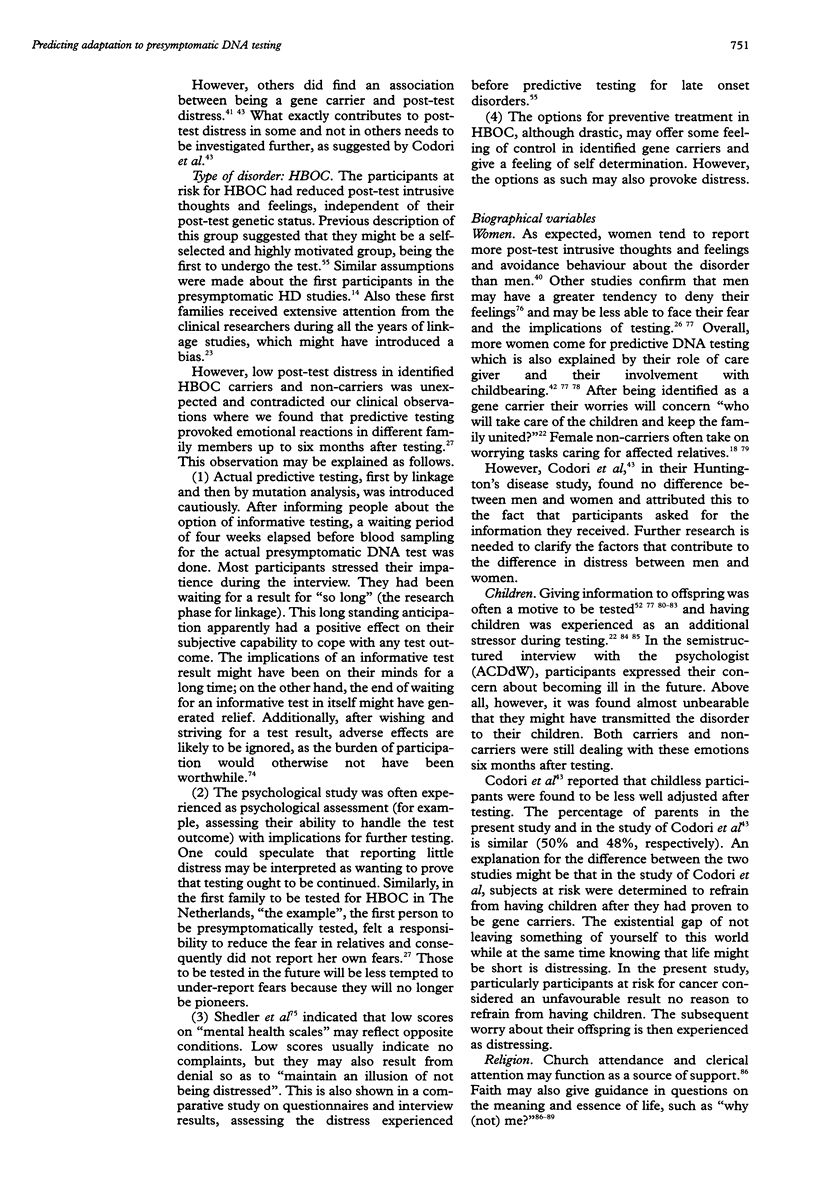
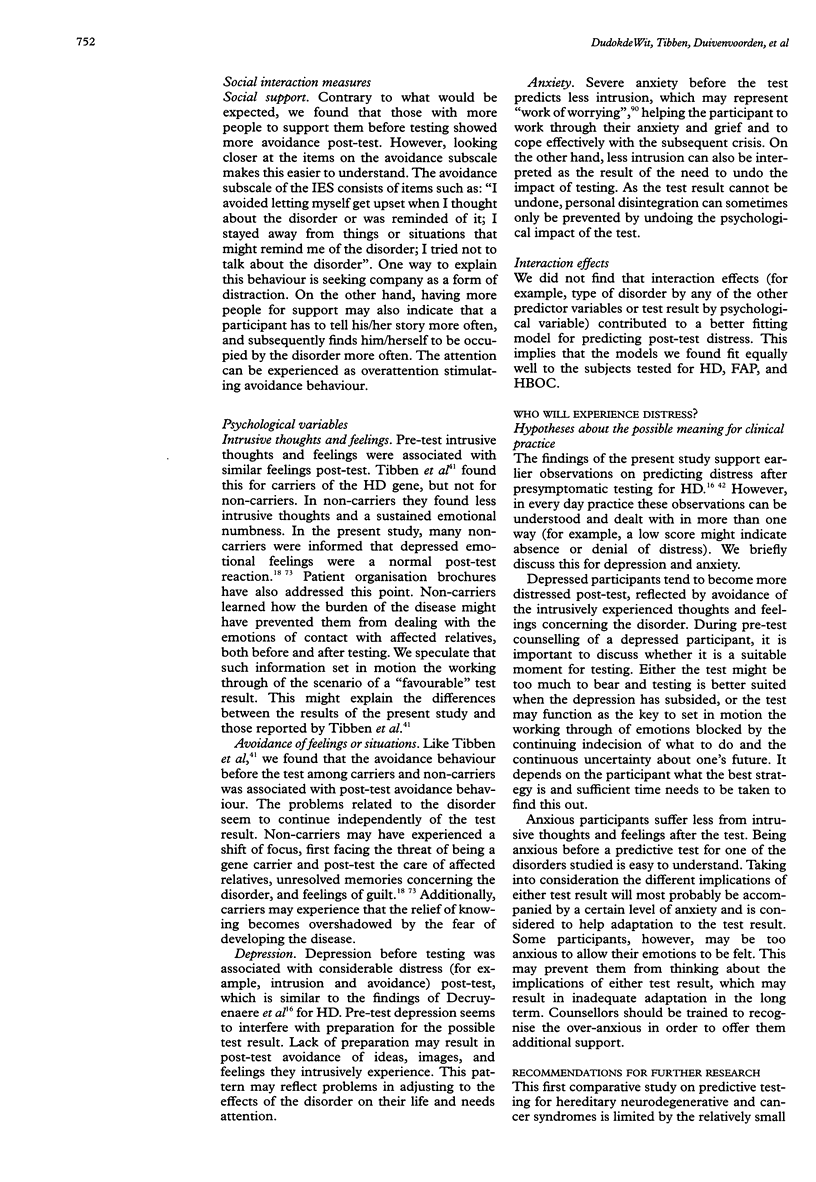
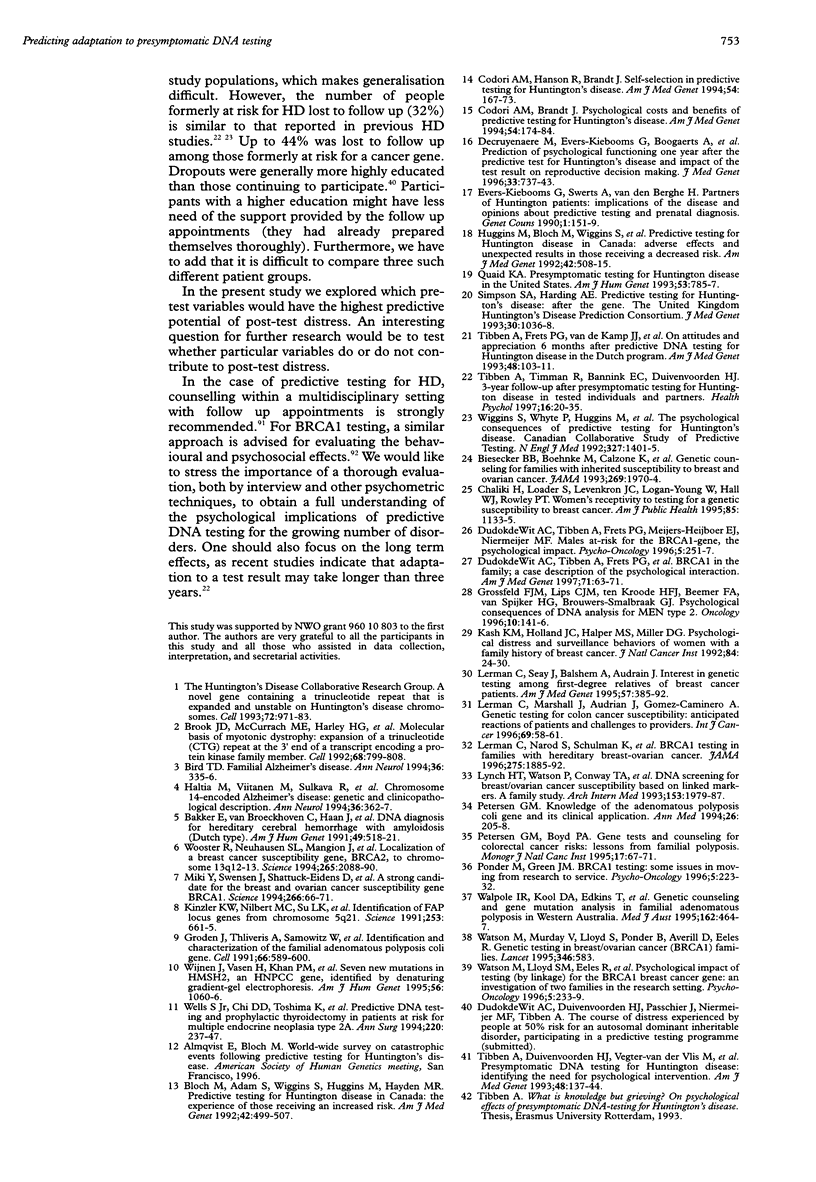
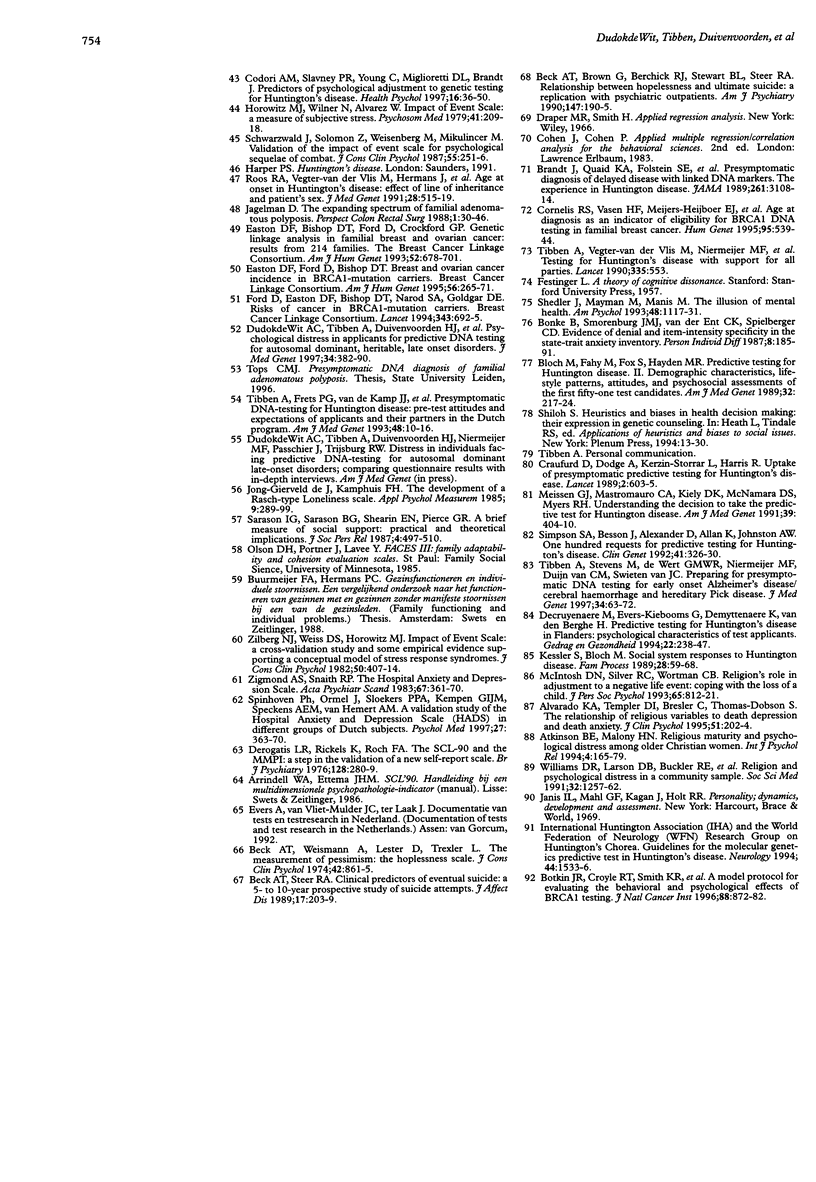
Selected References
These references are in PubMed. This may not be the complete list of references from this article.
- Alvarado K. A., Templer D. I., Bresler C., Thomas-Dobson S. The relationship of religious variables to death depression and death anxiety. J Clin Psychol. 1995 Mar;51(2):202–204. doi: 10.1002/1097-4679(199503)51:2<202::aid-jclp2270510209>3.0.co;2-m. [DOI] [PubMed] [Google Scholar]
- Bakker E., van Broeckhoven C., Haan J., Voorhoeve E., van Hul W., Levy E., Lieberburg I., Carman M. D., van Ommen G. J., Frangione B. DNA diagnosis for hereditary cerebral hemorrhage with amyloidosis (Dutch type) Am J Hum Genet. 1991 Sep;49(3):518–521. [PMC free article] [PubMed] [Google Scholar]
- Beck A. T., Brown G., Berchick R. J., Stewart B. L., Steer R. A. Relationship between hopelessness and ultimate suicide: a replication with psychiatric outpatients. Am J Psychiatry. 1990 Feb;147(2):190–195. doi: 10.1176/ajp.147.2.190. [DOI] [PubMed] [Google Scholar]
- Beck A. T., Steer R. A. Clinical predictors of eventual suicide: a 5- to 10-year prospective study of suicide attempters. J Affect Disord. 1989 Nov-Dec;17(3):203–209. doi: 10.1016/0165-0327(89)90001-3. [DOI] [PubMed] [Google Scholar]
- Beck A. T., Weissman A., Lester D., Trexler L. The measurement of pessimism: the hopelessness scale. J Consult Clin Psychol. 1974 Dec;42(6):861–865. doi: 10.1037/h0037562. [DOI] [PubMed] [Google Scholar]
- Biesecker B. B., Boehnke M., Calzone K., Markel D. S., Garber J. E., Collins F. S., Weber B. L. Genetic counseling for families with inherited susceptibility to breast and ovarian cancer. JAMA. 1993 Apr 21;269(15):1970–1974. [PubMed] [Google Scholar]
- Bird T. D. Familial Alzheimer's disease. Ann Neurol. 1994 Sep;36(3):335–336. doi: 10.1002/ana.410360303. [DOI] [PubMed] [Google Scholar]
- Bloch M., Adam S., Wiggins S., Huggins M., Hayden M. R. Predictive testing for Huntington disease in Canada: the experience of those receiving an increased risk. Am J Med Genet. 1992 Feb 15;42(4):499–507. doi: 10.1002/ajmg.1320420416. [DOI] [PubMed] [Google Scholar]
- Bloch M., Fahy M., Fox S., Hayden M. R. Predictive testing for Huntington disease: II. Demographic characteristics, life-style patterns, attitudes, and psychosocial assessments of the first fifty-one test candidates. Am J Med Genet. 1989 Feb;32(2):217–224. doi: 10.1002/ajmg.1320320215. [DOI] [PubMed] [Google Scholar]
- Botkin J. R., Croyle R. T., Smith K. R., Baty B. J., Lerman C., Goldgar D. E., Ward J. M., Flick B. J., Nash J. E. A model protocol for evaluating the behavioral and psychosocial effects of BRCA1 testing. J Natl Cancer Inst. 1996 Jul 3;88(13):872–882. doi: 10.1093/jnci/88.13.872. [DOI] [PubMed] [Google Scholar]
- Brandt J., Quaid K. A., Folstein S. E., Garber P., Maestri N. E., Abbott M. H., Slavney P. R., Franz M. L., Kasch L., Kazazian H. H., Jr Presymptomatic diagnosis of delayed-onset disease with linked DNA markers. The experience in Huntington's disease. JAMA. 1989 Jun 2;261(21):3108–3114. [PubMed] [Google Scholar]
- Brook J. D., McCurrach M. E., Harley H. G., Buckler A. J., Church D., Aburatani H., Hunter K., Stanton V. P., Thirion J. P., Hudson T. Molecular basis of myotonic dystrophy: expansion of a trinucleotide (CTG) repeat at the 3' end of a transcript encoding a protein kinase family member. Cell. 1992 Feb 21;68(4):799–808. doi: 10.1016/0092-8674(92)90154-5. [DOI] [PubMed] [Google Scholar]
- Chaliki H., Loader S., Levenkron J. C., Logan-Young W., Hall W. J., Rowley P. T. Women's receptivity to testing for a genetic susceptibility to breast cancer. Am J Public Health. 1995 Aug;85(8 Pt 1):1133–1135. doi: 10.2105/ajph.85.8_pt_1.1133. [DOI] [PMC free article] [PubMed] [Google Scholar]
- Codori A. M., Brandt J. Psychological costs and benefits of predictive testing for Huntington's disease. Am J Med Genet. 1994 Sep 15;54(3):174–184. doi: 10.1002/ajmg.1320540304. [DOI] [PubMed] [Google Scholar]
- Codori A. M., Hanson R., Brandt J. Self-selection in predictive testing for Huntington's disease. Am J Med Genet. 1994 Sep 15;54(3):167–173. doi: 10.1002/ajmg.1320540303. [DOI] [PubMed] [Google Scholar]
- Codori A. M., Slavney P. R., Young C., Miglioretti D. L., Brandt J. Predictors of psychological adjustment to genetic testing for Huntington's disease. Health Psychol. 1997 Jan;16(1):36–50. doi: 10.1037//0278-6133.16.1.36. [DOI] [PubMed] [Google Scholar]
- Cornelis R. S., Vasen H. F., Meijers-Heijboer H., Ford D., van Vliet M., van Tilborg A. A., Cleton F. J., Klijn J. G., Menko F. H., Meera Khan P. Age at diagnosis as an indicator of eligibility for BRCA1 DNA testing in familial breast cancer. Hum Genet. 1995 May;95(5):539–544. doi: 10.1007/BF00223866. [DOI] [PubMed] [Google Scholar]
- Craufurd D., Dodge A., Kerzin-Storrar L., Harris R. Uptake of presymptomatic predictive testing for Huntington's disease. Lancet. 1989 Sep 9;2(8663):603–605. doi: 10.1016/s0140-6736(89)90722-8. [DOI] [PubMed] [Google Scholar]
- Decruyenaere M., Evers-Kiebooms G., Boogaerts A., Cassiman J. J., Cloostermans T., Demyttenaere K., Dom R., Fryns J. P., Van den Berghe H. Prediction of psychological functioning one year after the predictive test for Huntington's disease and impact of the test result on reproductive decision making. J Med Genet. 1996 Sep;33(9):737–743. doi: 10.1136/jmg.33.9.737. [DOI] [PMC free article] [PubMed] [Google Scholar]
- Derogatis L. R., Rickels K., Rock A. F. The SCL-90 and the MMPI: a step in the validation of a new self-report scale. Br J Psychiatry. 1976 Mar;128:280–289. doi: 10.1192/bjp.128.3.280. [DOI] [PubMed] [Google Scholar]
- DudokdeWit A. C., Tibben A., Duivenvoorden H. J., Frets P. G., Zoeteweij M. W., Losekoot M., van Haeringen A., Niermeijer M. F., Passchier J. Psychological distress in applicants for predictive DNA testing for autosomal dominant, heritable, late onset disorders. The Rotterdam/Leiden Genetics Workgroup. J Med Genet. 1997 May;34(5):382–390. doi: 10.1136/jmg.34.5.382. [DOI] [PMC free article] [PubMed] [Google Scholar]
- DudokdeWit A. C., Tibben A., Frets P. G., Meijers-Heijboer E. J., Devilee P., Klijn J. G., Oosterwijk J. C., Niermeijer M. F. BRCA1 in the family: a case description of the psychological implications. Am J Med Genet. 1997 Jul 11;71(1):63–71. doi: 10.1002/(sici)1096-8628(19970711)71:1<63::aid-ajmg12>3.0.co;2-t. [DOI] [PubMed] [Google Scholar]
- Easton D. F., Bishop D. T., Ford D., Crockford G. P. Genetic linkage analysis in familial breast and ovarian cancer: results from 214 families. The Breast Cancer Linkage Consortium. Am J Hum Genet. 1993 Apr;52(4):678–701. [PMC free article] [PubMed] [Google Scholar]
- Easton D. F., Ford D., Bishop D. T. Breast and ovarian cancer incidence in BRCA1-mutation carriers. Breast Cancer Linkage Consortium. Am J Hum Genet. 1995 Jan;56(1):265–271. [PMC free article] [PubMed] [Google Scholar]
- Evers-Kiebooms G., Swerts A., Van Den Berghe H. Partners of Huntington patients: implications of the disease and opinions about predictive testing and prenatal diagnosis. Genet Couns. 1990;1(2):151–159. [PubMed] [Google Scholar]
- Ford D., Easton D. F., Bishop D. T., Narod S. A., Goldgar D. E. Risks of cancer in BRCA1-mutation carriers. Breast Cancer Linkage Consortium. Lancet. 1994 Mar 19;343(8899):692–695. doi: 10.1016/s0140-6736(94)91578-4. [DOI] [PubMed] [Google Scholar]
- Groden J., Thliveris A., Samowitz W., Carlson M., Gelbert L., Albertsen H., Joslyn G., Stevens J., Spirio L., Robertson M. Identification and characterization of the familial adenomatous polyposis coli gene. Cell. 1991 Aug 9;66(3):589–600. doi: 10.1016/0092-8674(81)90021-0. [DOI] [PubMed] [Google Scholar]
- Grosfeld F. J., Lips C. J., Ten Kroode H. F., Beemer F. A., Van Spijker H. G., Brouwers-Smalbraak G. J. Psychosocial consequences of DNA analysis for MEN type 2. Oncology (Williston Park) 1996 Feb;10(2):141-6; discussion 146, 152, 157. [PubMed] [Google Scholar]
- Haltia M., Viitanen M., Sulkava R., Ala-Hurula V., Poyhonen M., Goldfarb L., Brown P., Levy E., Houlden H., Crook R. Chromosome 14-encoded Alzheimer's disease: genetic and clinicopathological description. Ann Neurol. 1994 Sep;36(3):362–367. doi: 10.1002/ana.410360307. [DOI] [PubMed] [Google Scholar]
- Horowitz M., Wilner N., Alvarez W. Impact of Event Scale: a measure of subjective stress. Psychosom Med. 1979 May;41(3):209–218. doi: 10.1097/00006842-197905000-00004. [DOI] [PubMed] [Google Scholar]
- Huggins M., Bloch M., Wiggins S., Adam S., Suchowersky O., Trew M., Klimek M., Greenberg C. R., Eleff M., Thompson L. P. Predictive testing for Huntington disease in Canada: adverse effects and unexpected results in those receiving a decreased risk. Am J Med Genet. 1992 Feb 15;42(4):508–515. doi: 10.1002/ajmg.1320420417. [DOI] [PubMed] [Google Scholar]
- Kash K. M., Holland J. C., Halper M. S., Miller D. G. Psychological distress and surveillance behaviors of women with a family history of breast cancer. J Natl Cancer Inst. 1992 Jan 1;84(1):24–30. doi: 10.1093/jnci/84.1.24. [DOI] [PubMed] [Google Scholar]
- Kessler S., Bloch M. Social system responses to Huntington disease. Fam Process. 1989 Mar;28(1):59–68. doi: 10.1111/j.1545-5300.1989.00059.x. [DOI] [PubMed] [Google Scholar]
- Kinzler K. W., Nilbert M. C., Su L. K., Vogelstein B., Bryan T. M., Levy D. B., Smith K. J., Preisinger A. C., Hedge P., McKechnie D. Identification of FAP locus genes from chromosome 5q21. Science. 1991 Aug 9;253(5020):661–665. doi: 10.1126/science.1651562. [DOI] [PubMed] [Google Scholar]
- Lerman C., Marshall J., Audrain J., Gomez-Caminero A. Genetic testing for colon cancer susceptibility: Anticipated reactions of patients and challenges to providers. Int J Cancer. 1996 Feb 20;69(1):58–61. doi: 10.1002/(SICI)1097-0215(19960220)69:1<58::AID-IJC15>3.0.CO;2-G. [DOI] [PubMed] [Google Scholar]
- Lerman C., Narod S., Schulman K., Hughes C., Gomez-Caminero A., Bonney G., Gold K., Trock B., Main D., Lynch J. BRCA1 testing in families with hereditary breast-ovarian cancer. A prospective study of patient decision making and outcomes. JAMA. 1996 Jun 26;275(24):1885–1892. [PubMed] [Google Scholar]
- Lerman C., Seay J., Balshem A., Audrain J. Interest in genetic testing among first-degree relatives of breast cancer patients. Am J Med Genet. 1995 Jul 3;57(3):385–392. doi: 10.1002/ajmg.1320570304. [DOI] [PubMed] [Google Scholar]
- Lynch H. T., Watson P., Conway T. A., Lynch J. F., Slominski-Caster S. M., Narod S. A., Feunteun J., Lenoir G. DNA screening for breast/ovarian cancer susceptibility based on linked markers. A family study. Arch Intern Med. 1993 Sep 13;153(17):1979–1987. [PubMed] [Google Scholar]
- McIntosh D. N., Silver R. C., Wortman C. B. Religion's role in adjustment to a negative life event: coping with the loss of a child. J Pers Soc Psychol. 1993 Oct;65(4):812–821. doi: 10.1037//0022-3514.65.4.812. [DOI] [PubMed] [Google Scholar]
- Miki Y., Swensen J., Shattuck-Eidens D., Futreal P. A., Harshman K., Tavtigian S., Liu Q., Cochran C., Bennett L. M., Ding W. A strong candidate for the breast and ovarian cancer susceptibility gene BRCA1. Science. 1994 Oct 7;266(5182):66–71. doi: 10.1126/science.7545954. [DOI] [PubMed] [Google Scholar]
- Petersen G. M., Boyd P. A. Gene tests and counseling for colorectal cancer risk: lessons from familial polyposis. J Natl Cancer Inst Monogr. 1995;(17):67–71. [PubMed] [Google Scholar]
- Petersen G. M. Knowledge of the adenomatous polyposis coli gene and its clinical application. Ann Med. 1994 Jun;26(3):205–208. doi: 10.3109/07853899409147891. [DOI] [PubMed] [Google Scholar]
- Quaid K. A. Presymptomatic testing for Huntington disease in the United States. Am J Hum Genet. 1993 Sep;53(3):785–787. [PMC free article] [PubMed] [Google Scholar]
- Schwarzwald J., Solomon Z., Weisenberg M., Mikulincer M. Validation of the Impact of Event Scale for psychological sequelae of combat. J Consult Clin Psychol. 1987 Apr;55(2):251–256. doi: 10.1037//0022-006x.55.2.251. [DOI] [PubMed] [Google Scholar]
- Shedler J., Mayman M., Manis M. The illusion of mental health. Am Psychol. 1993 Nov;48(11):1117–1131. doi: 10.1037//0003-066x.48.11.1117. [DOI] [PubMed] [Google Scholar]
- Simpson S. A., Besson J., Alexander D., Allan K., Johnston A. W. One hundred requests for predictive testing for Huntington's disease. Clin Genet. 1992 Jun;41(6):326–330. doi: 10.1111/j.1399-0004.1992.tb03407.x. [DOI] [PubMed] [Google Scholar]
- Simpson S. A., Harding A. E. Predictive testing for Huntington's disease: after the gene. The United Kingdom Huntington's Disease Prediction Consortium. J Med Genet. 1993 Dec;30(12):1036–1038. doi: 10.1136/jmg.30.12.1036. [DOI] [PMC free article] [PubMed] [Google Scholar]
- Spinhoven P., Ormel J., Sloekers P. P., Kempen G. I., Speckens A. E., Van Hemert A. M. A validation study of the Hospital Anxiety and Depression Scale (HADS) in different groups of Dutch subjects. Psychol Med. 1997 Mar;27(2):363–370. doi: 10.1017/s0033291796004382. [DOI] [PubMed] [Google Scholar]
- Tibben A., Duivenvoorden H. J., Vegter-van der Vlis M., Niermeijer M. F., Frets P. G., van de Kamp J. J., Roos R. A., Rooijmans H. G., Verhage F. Presymptomatic DNA testing for Huntington disease: identifying the need for psychological intervention. Am J Med Genet. 1993 Oct 15;48(3):137–144. doi: 10.1002/ajmg.1320480305. [DOI] [PubMed] [Google Scholar]
- Tibben A., Frets P. G., van de Kamp J. J., Niermeijer M. F., Vegter-van der Vlis M., Roos R. A., van Ommen G. J., Duivenvoorden H. J., Verhage F. Presymptomatic DNA-testing for Huntington disease: pretest attitudes and expectations of applicants and their partners in the Dutch program. Am J Med Genet. 1993 May 1;48(1):10–16. doi: 10.1002/ajmg.1320480105. [DOI] [PubMed] [Google Scholar]
- Tibben A., Frets P. G., van de Kamp J. J., Niermeijer M. F., Vegtervan der Vlis M., Roos R. A., Rooymans H. G., van Ommen G. J., Verhage F. On attitudes and appreciation 6 months after predictive DNA testing for Huntington disease in the Dutch program. Am J Med Genet. 1993 Jul 15;48(2):103–111. doi: 10.1002/ajmg.1320480209. [DOI] [PubMed] [Google Scholar]
- Tibben A., Stevens M., de Wert G. M., Niermeijer M. F., van Duijn C. M., van Swieten J. C. Preparing for presymptomatic DNA testing for early onset Alzheimer's disease/cerebral haemorrhage and hereditary Pick disease. J Med Genet. 1997 Jan;34(1):63–72. doi: 10.1136/jmg.34.1.63. [DOI] [PMC free article] [PubMed] [Google Scholar]
- Tibben A., Timman R., Bannink E. C., Duivenvoorden H. J. Three-year follow-up after presymptomatic testing for Huntington's disease in tested individuals and partners. Health Psychol. 1997 Jan;16(1):20–35. doi: 10.1037//0278-6133.16.1.20. [DOI] [PubMed] [Google Scholar]
- Tibben A., Vegter-vd Vlis M., vd Niermeijer M. F., Kamp J. J., Roos R. A., Rooijmans H. G., Frets P. G., Verhage F. Testing for Huntington's disease with support for all parties. Lancet. 1990 Mar 3;335(8688):553–553. doi: 10.1016/0140-6736(90)90796-8. [DOI] [PubMed] [Google Scholar]
- Walpole I. R., Kool D. A., Edkins T., Creegan R., Levitt S., Francis S. T., Goldblatt J. Genetic counselling and gene mutation analysis in familial adenomatous polyposis in Western Australia. Med J Aust. 1995 May 1;162(9):464–467. doi: 10.5694/j.1326-5377.1995.tb140006.x. [DOI] [PubMed] [Google Scholar]
- Watson M., Murday V., Lloyd S., Ponder B., Averill D., Eeles R. Genetic testing in breast/ovarian cancer (BRCA1) families. Lancet. 1995 Aug 26;346(8974):583–583. doi: 10.1016/s0140-6736(95)91424-2. [DOI] [PubMed] [Google Scholar]
- Wells S. A., Jr, Chi D. D., Toshima K., Dehner L. P., Coffin C. M., Dowton S. B., Ivanovich J. L., DeBenedetti M. K., Dilley W. G., Moley J. F. Predictive DNA testing and prophylactic thyroidectomy in patients at risk for multiple endocrine neoplasia type 2A. Ann Surg. 1994 Sep;220(3):237–250. doi: 10.1097/00000658-199409000-00002. [DOI] [PMC free article] [PubMed] [Google Scholar]
- Wiggins S., Whyte P., Huggins M., Adam S., Theilmann J., Bloch M., Sheps S. B., Schechter M. T., Hayden M. R. The psychological consequences of predictive testing for Huntington's disease. Canadian Collaborative Study of Predictive Testing. N Engl J Med. 1992 Nov 12;327(20):1401–1405. doi: 10.1056/NEJM199211123272001. [DOI] [PubMed] [Google Scholar]
- Wijnen J., Vasen H., Khan P. M., Menko F. H., van der Klift H., van Leeuwen C., van den Broek M., van Leeuwen-Cornelisse I., Nagengast F., Meijers-Heijboer A. Seven new mutations in hMSH2, an HNPCC gene, identified by denaturing gradient-gel electrophoresis. Am J Hum Genet. 1995 May;56(5):1060–1066. [PMC free article] [PubMed] [Google Scholar]
- Williams D. R., Larson D. B., Buckler R. E., Heckmann R. C., Pyle C. M. Religion and psychological distress in a community sample. Soc Sci Med. 1991;32(11):1257–1262. doi: 10.1016/0277-9536(91)90040-j. [DOI] [PubMed] [Google Scholar]
- Wooster R., Neuhausen S. L., Mangion J., Quirk Y., Ford D., Collins N., Nguyen K., Seal S., Tran T., Averill D. Localization of a breast cancer susceptibility gene, BRCA2, to chromosome 13q12-13. Science. 1994 Sep 30;265(5181):2088–2090. doi: 10.1126/science.8091231. [DOI] [PubMed] [Google Scholar]
- Zigmond A. S., Snaith R. P. The hospital anxiety and depression scale. Acta Psychiatr Scand. 1983 Jun;67(6):361–370. doi: 10.1111/j.1600-0447.1983.tb09716.x. [DOI] [PubMed] [Google Scholar]
- Zilberg N. J., Weiss D. S., Horowitz M. J. Impact of Event Scale: a cross-validation study and some empirical evidence supporting a conceptual model of stress response syndromes. J Consult Clin Psychol. 1982 Jun;50(3):407–414. doi: 10.1037//0022-006x.50.3.407. [DOI] [PubMed] [Google Scholar]


